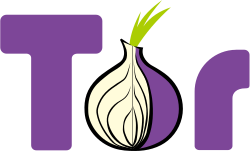History
The Tor Project, Inc. was founded on December 22, 2006 [5] by computer scientists Roger Dingledine, Nick Mathewson and five others. The Electronic Frontier Foundation (EFF) acted as the Tor Project's fiscal sponsor in its early years, and early financial supporters of the Tor Project included the U.S. International Broadcasting Bureau, Internews, Human Rights Watch, the University of Cambridge, Google, and Netherlands-based Stichting NLnet. [7] [8] [9] [11] [12]
In October 2014, the Tor Project hired the public relations firm Thomson Communications in order to improve its public image (particularly regarding the terms "Dark Net" and "hidden services") and to educate journalists about the technical aspects of Tor. [13]
In May 2015, the Tor Project ended the Tor Cloud Service. [14] [15]
In December 2015, the Tor Project announced that it had hired Shari Steele, former executive director of the Electronic Frontier Foundation, as its new executive director. Roger Dingledine, who had been acting as interim executive director since May 2015, remained at the Tor Project as a director and board member. [16] [17] [18] Later that month, the Tor Project announced that the Open Technology Fund would be sponsoring a bug bounty program that was coordinated by HackerOne. [19] [20] The program was initially invite-only and focuses on finding vulnerabilities that are specific to the Tor Project's applications. [19]
On May 25, 2016, Tor Project employee Jacob Appelbaum stepped down from his position; [21] [22] [23] this was announced on June 2 in a two-line statement by Tor. [24] Over the following days, allegations of sexual mistreatment were made public by several people. [23]
On July 13, 2016, the complete board of the Tor Project – Meredith Hoban Dunn, Ian Goldberg, Julius Mittenzwei, Rabbi Rob Thomas, Wendy Seltzer, Roger Dingledine and Nick Mathewson – was replaced with Matt Blaze, Cindy Cohn, Gabriella Coleman, Linus Nordberg, Megan Price and Bruce Schneier. [25] [26] [27] [28] A new anti-harassment policy has been approved by the new board, as well as a conflicts of interest policy, procedures for submitting complaints, and an internal complaint review process. [29] [30] The affair continues to be controversial, with considerable dissent within the Tor community. [31]
In 2020, due to the COVID-19 pandemic, the Tor project's core team let go of 13 employees, leaving a working staff of 22 people. [32]
In 2023, the Tails Project approached the Tor Project to merge operations. The merger was completed on September 26, 2024, stating that, "By joining forces, the Tails team can now focus on their core mission of maintaining and improving Tails OS, exploring more and complementary use cases while benefiting from the larger organizational structure of The Tor Project." [33] [34]
Recognition
In March 2011, the Tor Project received the Free Software Foundation's 2010 Award for Projects of Social Benefit. The citation read, "Using free software, Tor has enabled roughly 36 million people around the world to experience freedom of access and expression on the Internet while keeping them in control of their privacy and anonymity. Its network has proved pivotal in dissident movements in both Iran and more recently Egypt." [43]
In September 2012, the Tor Project received the 2012 EFF Pioneer Award, along with Jérémie Zimmermann and Andrew Huang. [44]
In November 2012, Foreign Policy magazine named Dingledine, Mathewson, and Syverson among its Top 100 Global Thinkers "for making the web safe for whistleblowers". [45]
In 2014, Roger Dingledine, Nick Mathewson and Paul Syverson received the USENIX Test of Time Award for their paper titled "Tor: The Second-Generation Onion Router", which was published in the Proceedings of the 13th USENIX Security Symposium, August 2004. [46]
In 2021, the Tor Project was awarded the Levchin Prize for real-world cryptography. [47]
This page is based on this
Wikipedia article Text is available under the
CC BY-SA 4.0 license; additional terms may apply.
Images, videos and audio are available under their respective licenses.
